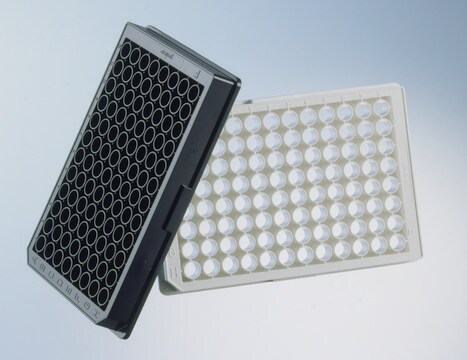MABS1984
Anti-INTS1 Antibody, clone 4.47
clone 4.47, from mouse
Synonym(s):
Integrator complex subunit 1, Int1
Sign Into View Organizational & Contract Pricing
All Photos(1)
About This Item
UNSPSC Code:
12352203
eCl@ss:
32160702
Recommended Products
biological source
mouse
Quality Level
antibody form
purified immunoglobulin
antibody product type
primary antibodies
clone
4.47, monoclonal
species reactivity
human
technique(s)
western blot: suitable
isotype
IgG1κ
NCBI accession no.
UniProt accession no.
shipped in
ambient
target post-translational modification
unmodified
Gene Information
human ... INTS1(26173)
General description
Integrator complex subunit 1 (UniProt Q8N201; also known as Int1) is encoded by the INTS1 (also known as KIAA1440, UNQ1821/PRO3434) gene (Gene ID 26173) in human. INTS1 is a large protein that is a component of the integrator complex that is involved in small nuclear RNAs U1 and U2 transcription and their 3′-box-dependent processing. During transcriptional regulation and in RNA processing, it directly binds to the C-terminal domain of the RNA polymerase II largest subunit. It has been reported that INTS1 is also involved in different cell support processes, such as the formation of a scaffold for the assembly of integrator complex. Developing INTS1 (-/-) mouse embryos show growth arrest at the early blastocyst stage and exhibit activated caspase-3 and caspase-7 that induce apoptosis within the inner cell mass of blastocyst.
Ref.:
Baillat, D et al. (2005). Cell 123, 265-276.
Hata T., and Nakayama, M (2007), Biochim. Biophys. Acta 1773, 1039-1051.
Ref.:
Baillat, D et al. (2005). Cell 123, 265-276.
Hata T., and Nakayama, M (2007), Biochim. Biophys. Acta 1773, 1039-1051.
Specificity
Clone 4.47 targets an epitope in the central region of human INTS1 protein.
Immunogen
GST-tagged recombinant human INTS1 internal fragment.
Application
Anti-INTS1, clone 4.47 Antibody, Cat. No. MABS1984, is a highly specific mouse monoclonal antibody, that targets INTS1 and has been tested in Western Blotting.
Research Category
Epigenetics & Nuclear Function
Epigenetics & Nuclear Function
Quality
Evaluated by Western Blotting in HeLa cell lysate.
Western Blotting Analysis: 2 µg/mL of this antibody detected in 50 µg of HeLa cell lysate.
Western Blotting Analysis: 2 µg/mL of this antibody detected in 50 µg of HeLa cell lysate.
Target description
~240 kDa observed. 244.3 kDa calculated. Uncharacterized bands may be observed in some lysate(s).
Physical form
Format: Purified
Protein G purified.
Purified mouse IgG1κ in buffer containing 0.1 M Tris-Glycine (pH 7.4), 150 mM NaCl with 0.05% sodium azide.
Storage and Stability
Stable for 1 year at 2-8°C from date of receipt.
Other Notes
Concentration: Please refer to lot specific datasheet.
Disclaimer
Unless otherwise stated in our catalog or other company documentation accompanying the product(s), our products are intended for research use only and are not to be used for any other purpose, which includes but is not limited to, unauthorized commercial uses, in vitro diagnostic uses, ex vivo or in vivo therapeutic uses or any type of consumption or application to humans or animals.
Not finding the right product?
Try our Product Selector Tool.
Storage Class Code
12 - Non Combustible Liquids
WGK
WGK 1
Certificates of Analysis (COA)
Search for Certificates of Analysis (COA) by entering the products Lot/Batch Number. Lot and Batch Numbers can be found on a product’s label following the words ‘Lot’ or ‘Batch’.
Already Own This Product?
Find documentation for the products that you have recently purchased in the Document Library.
Felipe Beckedorff et al.
Cell reports, 32(3), 107917-107917 (2020-07-23)
Transcription by RNA polymerase II (RNAPII) is pervasive in the human genome. However, the mechanisms controlling transcription at promoters and enhancers remain enigmatic. Here, we demonstrate that Integrator subunit 11 (INTS11), the catalytic subunit of the Integrator complex, regulates transcription
Jasmine Barra et al.
Science advances, 6(27), eaaz9072-eaaz9072 (2020-09-15)
RNA 3' end processing provides a source of transcriptome diversification which affects various (patho)-physiological processes. A prime example is the transcript isoform switch that leads to the read-through expression of the long non-coding RNA NEAT1_2, at the expense of the
Stephin J Vervoort et al.
Cell, 184(12), 3143-3162 (2021-05-19)
Gene expression by RNA polymerase II (RNAPII) is tightly controlled by cyclin-dependent kinases (CDKs) at discrete checkpoints during the transcription cycle. The pausing checkpoint following transcription initiation is primarily controlled by CDK9. We discovered that CDK9-mediated, RNAPII-driven transcription is functionally
Our team of scientists has experience in all areas of research including Life Science, Material Science, Chemical Synthesis, Chromatography, Analytical and many others.
Contact Technical Service